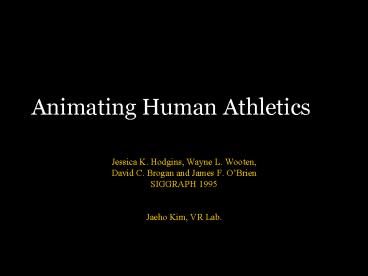Animating Human Athletics PowerPoint PPT Presentation
1 / 39
Title: Animating Human Athletics
1
Animating Human Athletics
- Jessica K. Hodgins, Wayne L. Wooten,
- David C. Brogan and James F. OBrien
- SIGGRAPH 1995
- Jaeho Kim, VR Lab.
2
Animating Human Athletics
- Dynamic simulation of human motion
- Running
- Cycling
- Vaulting
3
Preliminary
- Passive system
- Active system
- Torque
- Inverse kinematics
4
Passive systems vs. Active systems
- Passive systems
- Only external forces alter the motion of the
system - Examples Leaves, water spray, and clothing
- Active systems
- Motors, muscles, or other internal forces control
the motion of the system - Examples Running human, and swimming fish
5
Torque
- Rigid body dynamics
- Newtons equation for translations
- Eulers equation for rotational motion
- Torque
6
Inverse kinematics
- Inverse kinematics
- Given location and orientation of end effector,
find joint variables
?
7
Animating Human Athletics
- Dynamic simulation of human motion
- Running
- Cycling
- Vaulting
- Control algorithms
- state machines that describe each specific motion
8
Related work
- Robotics
- Biomechanics
- Motion capture data
- Muscle activation data
- Energy curve
- Stance duration, flight duration, step length
- Computer graphics
- Jack system
9
Problems
10
Problems
- Human models ?
- Dynamics ?
- Controls ?
- Visualization ?
System design
11
System design
- Active system
desired behavior
Forces and torques
Model
User
Control
Numerical Integrator
state
graphics
12
System design
- Active system
desired behavior
Forces and torques
Model
User
Control
SDFast from Symbolic Dynamics
state
graphics
13
Human model
- Between 15 and 17 regid bodies connected with
rotary joints, allowing 22 to 32 controlled DOF - Body segment densities obtained from
biomechanical data - Mass and moments of inertia calculated from the
polygonal model
14
Control Algorithms
Forces and torques
desired behavior
Control
- state machines connecting phase of behavior to
active control laws
15
Control Algorithms
Forces and torques
desired behavior
Control
- Control the primary actions using equations for
motion - Basic process (for each time step)
- calculate joint positions and velocities
- compute joint torque (with proportional-derivative
servos) - integrate equations of motion
- Hand designed and tuned
16
Control Laws
Forces and torques
desired behavior
Control
- Proportional-derivative servos
- To compute the force required to move joints to
the desired position
17
System design
- Active system
desired behavior
Forces and torques
Model
User
Control
SDFast from Symbolic Dynamics
state
graphics
18
Human Motion
- Running
- Bicycling
- Vaulting
19
Running
20
Active Leg
- At touchdown
- The desired distance from the hip to the heel
projected onto the ground plane - To compute the desired knee and hip angle
- ? xhh, yhh, and zhh,
- ? the inverse kinematics of the leg
- Related to forward velocity
21
(No Transcript)
22
- Proportional-derivative servos are used to
compute torques for the hip joint of the stance
leg
23
Idle Leg
- To be shortened so that the toe does not stub the
ground - The hip angles mirror the motion of the active leg
24
Sh0ulder
25
(No Transcript)
26
Bicycling
- (two-sided) Spring and damper systems
- The hands to the handlebars
- The feet to the pedals
- The crank to the rear wheel
27
The desired torque at the crank
- The desired torque at the crank
- The desired forces from the left and right legs
28
Steering
- a roll angle
- ß yaw angle
29
(No Transcript)
30
Vaulting
- Spring board
- Spring and damper model
31
Putting the hands on the horse
32
Balance controller
- Center of mass must remain over the support
polygon - Controller derives desired joint angles based on
the error between the desired center of mass and
the actual center of mass - Knee angle computed to maintain body height
33
(No Transcript)
34
Higher-level behaviors
- Choreographing an animation with many bicyclists
or runners - difficult !!!
- Implemented the Reynolds algorithm
- To control a group where the members have
dynamics - Refer to Brogan and Hodgins, Group behaviors for
systems with significant dynamics, IEEE/RSJ
International Conference on Intelligent robot and
systems, 1995
35
Secondary motions
- Sweatpants
- Splashing water
36
(No Transcript)
37
Conclusion
- Dynamic simulation of human motion
- Running
- Cycling
- Vaulting
- Control algorithms
- state machines that describe each specific motion
- Control the primary actions using equations for
motion
38
Discussion
- Advantages
- produce physically correct/realistic motions
- easy to create simulated motion
- can easily create similar motions
- Disadvantages
- robust algorithms difficult to create
- require detailed knowledge of the system
- computational expense grows with constraints
- generally accurate only for one complete action
Human simulation, Keith Thoresz, Suan Yong,
April 6, 1999
39
References
- Marc H. Raibert, Jessica K. Hodgins, Animation
of Dynamic Legged Locomotion, SIGGRAPH 1991. - Jessica K. Hodgins, Three-Dimensional Human
Running, In Proceedings of IEEE Conference on
Robotics and Automation, 1996. - Dynamic Behaviors for Real-Time Synthesis
Humans, SIGGRAPH 1995 Course Notes

